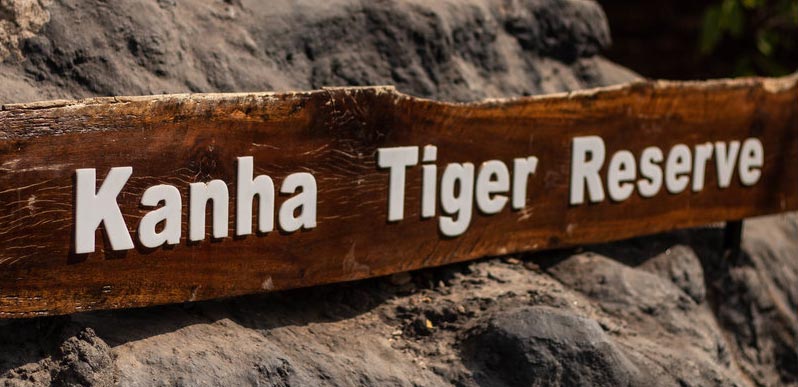Originally, the Kanha National Park was a part of the Gondwanas or the “Land of the Gonds”. The Forest area of the Kanha Tiger Reserve was inhabited by two of the indigenous tribes of Central India, namely the Baigas and the Gonds. The National Park is still occupied by the villagers of these tribes.
Kanha National Park is situated in the Mandla and Balaghat districts of Madhya Pradesh and is occupied by the two major sanctuaries i.e. the Banjar and Hallon Sanctuaries covering an area of 300 and 250 sq. km respectively forming the stupendous area of 1,949 sq. km. of the Kanha National Park.

The Timeline of Kanha Tiger Reserve makes it simpler to understand:
1800- The Area was being ruled by the Gond Dynasty for many centuries before the 19th century and the forested area of Kanha was little known for the slash and burn cultivation methods of both the Gond and Baiga Tribes were being controlled in that area as they had the good knowledge of the animals and their behaviours.
1862- During the 19th century, it marks an important year in the history of the Kanha Tiger Reserve when the first forest management rules were established and cutting of various tree species like Teak, Sal, Bija, and Shisham without official authorization was prohibited.
1857-1871- This Phase has exceptional importance as the Kanha Tiger Reserve area was best known to came into existence when Captain J. Forsyth wrote the Classic “The Highlands of Central India” and the book was published in the year 1913 and is a highly readable combination of forest survey, ethnography, and personal memoir. Captain J. Forsyth was an officer in the Bengal Staff Corps and discovered Pachmarhi Hill situated in the Satpura National Park in Central India.
1879- Kanha Area was declared as a Reserve Forest.
1880- In 1880, during the British era, Rudyard Kipling's imaginations for "The Jungle Book" stories made this region of Madhya Pradesh more valuable. The Stupendous landscapes in the forest of Pench and Kanha are really benevolent.
1923- It was the year when a landmark classic book was published, entitled “Wild Animals in Central India” which was completely focused on the Kanha Wildlife and was written by A. A. Dunbar Brander, a government official, and a keen observant amateur naturalist.
1933- It was the year when Kanha Forest Area was declared a Sanctuary.
1935- During the year 1935, the same status was accorded in the Eastern Sector to Supkhar but within a few years the wildlife safeguarded in this area came to an end due to the damage caused by the animals to the Field Crops, Sal Saplings, and Livestock. Over the next 20 years, the shooting of tigers and deer was periodically allowed.
1947-51- 30 Tigers were shot by the King of Vijaynagaram in the Kanha Tiger Reserve.
1955-75- This Phase was under the spotlight and introduced the new national park to the frontline in wildlife research and conservation efforts.
1963-65- The American Scientist George Schaller carried out initiating and detailed research on the Kanha Ecosystem.
1967- With the title “The Deer and the Tiger” his research was published as a persuasive book in 1967.
1969- The Park management started relocating villages within the core areas like Sonf, Gorhela, and Bishanpura in early 1969, and the good management between the neighbourhood area and the reserve has been the key factor of its success in the conservation efforts.
1970- To encourage the breeding and safeguard the hard ground Barasingha “the jewel of Kanha” from extinction, an exceptional enclosure was built inside the reserve. Furthermore, an increase in the Barasingha species was seen from 66 to 400-500 range.
1980- For Stanley Breeden and Belinda Wright, the Kanha National Park became the perfect location for the award winning National Geographic Film, “Land of the Tigers”. Both Kanha and Ranthambore (in Rajasthan) parks witnessed the success of the first phase of Project Tiger in the same year, and the number of visitors also dramatically increased in both national parks.
1989-1991- During this phase, an intense collaboration at Kanha Tiger Reserve between the Centre for Environmental Education in Ahmedabad and the United States National Park Service resulted in the installation of a multi-faceted informational program at Kanha comprising a park museum at Kisli, two orientation centers and a variety of publications.
1991- During the early 1990s, the Kanha Tiger Reserve was devoted to enhancing its biodiversity, expanding tourist infrastructure, and maintaining its desirable record for research, monitoring, and security. Undoubtedly, according to many observers, Kanha is the main national park in India and one of the most exquisite wildlife reserves in the world.
2000- Announced by the Department of Tourism, Government of India, the Kanha National Park was awarded as the best tourism friendly national park.


